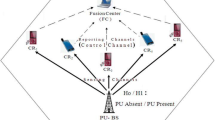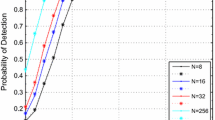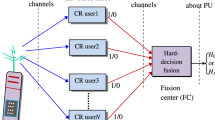Abstract
Cooperative spectrum sensing (CSS) is crucial for dynamic spectrum access in cognitive radio networks. This paper considers a CSS scheme by using a multilevel quantizer in each sensing node (SN) to quantize the local energy detector’s observation. A log-likelihood ratio test detector by using quantized data received from each SN is proposed to determine the presence or absence of the primary user signal. The Bhattacharyya distance (BD) of the cooperative sensing system is derived. Then, a quantizer design scheme by maximizing the BD that as the criterion function in an optimization problem with respect to the quantization thresholds is proposed. As nonlinear and high-dimensional of the objective function, a particle swarm optimization algorithm is employed to solve operating parameters for the quantizer. Furthermore, we derive the upper bound performance on cooperative energy detection (CED) in CSS. To validate the effectiveness of the proposed approach, The quantizer is compared with other schemes in terms of detection performance. Simulation results show that 2- or 3-bit quantization of the proposed approach achieves comparable performance to upper bound of CED without quantization.








Similar content being viewed by others
References
Axell, E., Leus, G., Larsson, E. G., & Poor, H. V. (2012). Spectrum sensing for cognitive radio: State-of-the-art and recent advances. IEEE Signal Process. Magazine, 29(3), 101–116.
Liu, X., Jia, M., Na, Z., et al. (2018). Multi-modal cooperative spectrum sensing based on Dempster–Shafer fusion in 5G-based cognitive radio. IEEE Access, 6(99), 199–208.
Akylidiz, I., Lo, B., & Balakrishan, R. (2011). Cooperative spectrum sensing in cognitive radio networks: A survey. Physical Communication, 4(1), 40–62.
Sriharipriya, K. C., & Baskaran, K. (2018). Optimal number of cooperators in the cooperative spectrum sensing schemes. Circuits Systems & Signal Processing, 37(5), 1988–2000.
Zhu, S., Akofor, E., & Chen, B. (2013). Interactive distributed detection with conditionally independent observations. In Proceedings of IEEE wireless communications and networking conference (pp. 2531–2535). Shanghai.
Yang, X., Niu, R., Masazade, E., & Varshney, P. (2013). Channel-aware tracking in multi-hop wireless sensor networks with quantized measurements. IEEE Transactions on Aerospace and Electronic Systems, 49(4), 2353–2368.
Gohain, P., & Chaudhari, S. (2017). Cooperative energy detection using Dempster–Shafer theory under noise uncertainties. In Proceedings of IEEE COMSNET (pp. 360–366). Bangalore.
Thanh, N., & Koo, I. (2009). An enhanced cooperative spectrum sensing scheme based on evidence theory and reliability source evaluation in cognitive radio context. IEEE Communications Letters, 13(7), 492–494.
Boulogeorgos, A. A., Chatzidiamantis, N. D., & Karagiannidis, G. K. (2016). Spectrum sensing with multiple primary users over fading channels. IEEE Communications Letters, 20(7), 1457–1460.
Boulogeorgos, A. A., Salameh, H. A. B., & Karagiannidis, G. K. (2017). Spectrum sensing in full-duplex cognitive radio networks under hardware imperfections. IEEE Transactions on Vehicular Technology, 66(3), 2072–2084.
Boulogeorgos, A. A. A., & Karagiannidis, G. K. (2018). Energy detection in full-duplex systems with residual RF impairments over fading channels. IEEE Wireless Communications Letters, 7(2), 246–249.
Cacciapuoti, A., Caleffi, M., Izzo, D., & Paura, L. (2011). Cooperative spectrum sensing techniques with temporal dispersive reporting channels. IEEE Transactions on Wireless Communications, 10(10), 3392–3402.
Cacciapuoti, A. S., Caleffi, M., & Paura, L. (2010). Widely linear cooperative spectrum sensing for cognitive radio networks. In IEEE global telecommunications conference (pp. 1–5). Florida.
Xin, L., Min, J., Xueyan, Z., & et al (2018). A novel multi-channel internet of things based on dynamic spectrum sharing in 5G communication. IEEE Internet of Things Journal, 14(8), 1–9.
Liu, X., Li, F., & Na, Z. (2017). Optimal resource allocation in simultaneous cooperative spectrum sensing and energy harvesting for multichannel cognitive radio. IEEE Access, 5, 3801–3812.
Liu, X., Zhang, X., Jia, M., et al. (2018). 5G-based green broadband communication system design with simultaneous wireless information and power transfer. Physical Communication, 28, 130–137.
Cacciapuoti, S. A., Caleffi, M., et al. (2013). Decision maker approaches for cooperative spectrum sensing: participate; or not participate in sensing? IEEE Transactions on Wireless Communications, 12(5), 2445–2457.
Cacciapuoti, A. S., Akyildiz, I. F., & Paura, L. (2012). Correlation-aware user selection for cooperative spectrum sensing in cognitive radio ad hoc networks. IEEE Journal on Selected Areas in Communications, 30(2), 297–306.
Liang, Y.-C., Zeng, Y., Peh, E. C., & Hoang, A. T. (2008). Sensing throughput tradeoff in cognitive radio networks. IEEE Transactions on Wireless Communications, 7(4), 1326–1337.
Nguyen-Thanh, N., & Koo, I. (2011). Evidence-theory-based cooperative spectrum sensing with efficient quantization method in cognitive radio. IEEE Transactions on Vehicular Technology, 60(1), 185–195.
Oh, D., Lee, H., & Lee, H. Y. (2010). Linear hard decision combining for cooperative spectrum sensing in cognitive radio systems. In Proceedings of 71nd IEEE vehicular technology conference (pp. 1–5). Taipei.
Althunibat, S., Palacios, R., & Granelli, F. (2012). Performance optimisation of soft and hard spectrum sensing schemes in cognitive radio. IEEE Communications Letters, 16(7), 998–1001.
Althunibat, S., & Granelli, F. (2014). Energy efficiency analysis of soft and hard cooperative spectrum sensing schemes in cognitive radio networks. In Proceedings of 79th IEEE vehicular technology conference (pp. 18–21). Seoul.
Ma, J., Zhao, G., & Li, Y. G. (2008). Soft combination and detection for cooperative spectrum sensing in cognitive radio networks. IEEE Transactions on Wireless Communications, 7(11), 4502–4507.
Nguyen-Thanh, N., Ciblat, P., Maleki, S., & Nguyen, V.-T. (2015). How many bits should be reported in quantized cooperative spectrum sensing? IEEE Wireless Communications Letters, 4(5), 465–468.
Verma, P., & Singh, B. (2017). On the decision fusion for cooperative spectrum sensing in cognitive radio networks. Wireless Networks, 23(7), 2253–2262.
Nhan, N.-T., & Insoo, K. (2011). Log-likelihood ratio optimal quantizer for cooperative spectrum sensing in cognitive radio. IEEE Communications Letters, 15(3), 317–319.
Tarighati, A., & Jalden, J. (2016). Optimality of rate balancing in wireless sensor networks. IEEE Transactions on Signal Processing, 64(14), 3735–3794.
Mhanna, M., Duhamel, P., & Piantanida, P. (2016). Quantization for distributed binary detection under secrecy constraints. In Proceedings of IEEE international conference on communications (pp. 1–6). Kuala Lumpur.
Tarighati, A., Gross, J., & Jalden, J. (2017). Decentralized hypothesis testing in energy harvesting wireless sensor networks. IEEE Transactions on Signal Processing, 65(18), 4862–4873.
Shin, I., Lee, W., Kang, J., Kang, J., & Al-Araji, S. (2015). Quantization bit allocation for reporting-throughput tradeoff in cooperative cognitive radio networks. In Proceedings of IEEE MILCOM (pp. 233–237). Tampa.
Bastami, B. A., & Saberinia, E. (2013). A practical multibit data combining strategy for cooperative spectrum sensing. IEEE Transactions on Vehicular Technology, 62(1), 384–389.
Ejaz, W., Hattab, G., Attia, T., Ibnkahla, M., Abdelkefi, F., & Siala, M. (2016). Joint quantization and confidence-based generalized combining scheme for cooperative spectrum sensing. IEEE Systems Journal, 12(2), 1–12.
Berisha, V., Wisler, A., Hero, A. O., & Spanias, A. (2016). Empirically estimable classification bounds based on a nonparametric divergence measure. IEEE Transactions on Signal Processing, 64(3), 580–591.
Kailath, T. (1967). The divergence and Bhattacharyya distance measures in signal selection. IEEE Trans. Commun. Technol., 15(1), 52–60.
Chernoff, H. (1952). A measure of asymptotic efficiency for tests of a hypothesis based on the sum of observations. The Annals of Mathematical Statistics, 23(4), 493–507.
Cover, T. M., & Thomas, J. A. (2012). Elements of information theory. Hoboken: Wiley.
Hero, A. O., Ma, B., Michel, O., & Gorman, J. (2001). Alpha-divergence for classification, indexing and retrieval (online). http://web.eecs.umich.edu/~hero/Preprints/cspl-328.pdf.
Jiang, M., Luo, Y. P., & Yang, S. Y. (2007). Stochastic convergence analysis and parameter selection of the standard particle swarm optimization algorithm. Information Processing Letter, 102(1), 8–16.
Gao, F., Guo, L., Li, H., et al. (2014). Quantizer design for distributed GLRT detection of weak signal in wireless sensor networks. IEEE Transactions on Wireless Communications, 14(4), 2032–2042.
Duarte, C., Barner, K. E., & Goossen, K. (2016). Design of IIR multi-notch filters based on polynomially-represented squared frequency response. IEEE Transactions on Signal Processing, 64(10), 2613–2623.
Acknowledgements
This work was supported by the Sichuan Province Science and Technology Program Research Project (No. 2019YJ0174). The authors would like to thank anonymous reviewers and editors for their constructive comments.
Author information
Authors and Affiliations
Corresponding author
Additional information
Publisher's Note
Springer Nature remains neutral with regard to jurisdictional claims in published maps and institutional affiliations.
Rights and permissions
About this article
Cite this article
Fu, Y., He, Z. Bhattacharyya distance criterion based multibit quantizer design for cooperative spectrum sensing in cognitive radio networks. Wireless Netw 25, 2665–2674 (2019). https://doi.org/10.1007/s11276-019-01986-9
Published:
Issue Date:
DOI: https://doi.org/10.1007/s11276-019-01986-9




